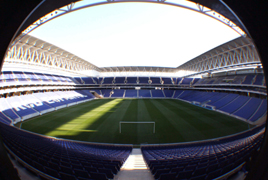The stadium of RCD Espanyol de Barcelona is already a reality
40,000 spectators are to enjoy the club's new facilities on 2 August

The new stadium is located in Plana del Galet, between the N-II and Avenida del Baix Llobregat, by the Plaza del Maresme. It has been built by FCC as part of a joint venture and cost 65 million euros.
The official inauguration will take place on 2 August, with the match between Malaga CF and Liverpool FC.
The project, designed by the architects Esteban Gasulla and Mark Fenwick, encompasses the stadium, with a seating capacity of 40,000, the offices, a club museum, different premises for various uses and the construction of a two level car park with 250 spaces, in addition to the connections with the training grounds and the Cornellá pitch.
It is made up of several areas: the bowl, formed by different floors of stands with a rectilinear design and crystallographic appearance; the roof, a ring or perimeter wall, that surrounds the bowl with a circular building, and the façade, which is understood as a floating translucent curtain that covers the different pieces of the ring and supports the club's representative function. All this is achieved through the incorporation of an outer skin of blue, white and transparent u-glass, which allows daylight to filter through to the interior spaces.
The stadium has been designed with accessibility for the disabled in mind. All of the stadium's routes comply with the regulatory standard, both inside and out, with a total of 0.05% of the inside premises having been adapted. From an efficiency and energy saving point of view, the roof is made of photovoltaic panels with a total surface area of 7,000 m2. In addition, this is an emblematic element alongside the integral energy-saving high performance luminaires, with some 650 megawatts of power.
FCC's background in building football stadiums
Grupo FCC has a proven track record in the construction of large stadiums throughout the world. Its most prominent references include the Allianz Arena stadium in Munich, the venue of the official inauguration of the FIFA World Cup Germany 2006 and one of the most spectacular stadiums in the world. It has remodelled and expanded the Santiago Bernabéu stadium, for Real Madrid; the Vicente Calderón stadium for Atlético de Madrid; the Camp Nou facilities, for FC Barcelona; the football pitch of El Sardinero in Santander; the Joan Gamper training ground, for FC Barcelona and Real Madrid's new training ground in Valdebebas. In 2007, it won a contract to build the new stadium of Valencia CF with a seating capacity of 75,000, replacing the former Mestalla stadium.
For Eurocup 2008, through its subsidiary ALPINE, FFC has remodelled and expanded the Wals-Siezenheim stadium in Saltsburg, seating 30,000, the Tivoli stadium in Innsbruck, seating 31,600 and the Wörthersee stadium in Klagenfurt, which has been awarded the Construction Prize by the State of Carinthia in Austria.
For Eurocup 2011, hosted by Poland, FCC will build the Baltic Arena stadium in Gdansk, seating 44,000; the Poznan stadium in Posen, seating 47,000; the National Stadium in Warsaw, seating 55,000 and will remodel and expand the stadium in Krakow.








